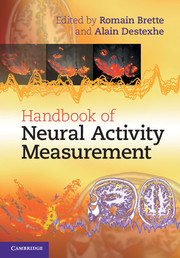Book contents
- Frontmatter
- Contents
- List of contributors
- 1 Introduction
- 2 Electrodes
- 3 Intracellular recording
- 4 Extracellular spikes and CSD
- 5 Local field potentials
- 6 EEG and MEG: forward modeling
- 7 MEG and EEG: source estimation
- 8 Intrinsic signal optical imaging
- 9 Voltage-sensitive dye imaging
- 10 Calcium imaging
- 11 Functional magnetic resonance imaging
- 12 Perspectives
- Plate section
- References
6 - EEG and MEG: forward modeling
Published online by Cambridge University Press: 05 October 2012
- Frontmatter
- Contents
- List of contributors
- 1 Introduction
- 2 Electrodes
- 3 Intracellular recording
- 4 Extracellular spikes and CSD
- 5 Local field potentials
- 6 EEG and MEG: forward modeling
- 7 MEG and EEG: source estimation
- 8 Intrinsic signal optical imaging
- 9 Voltage-sensitive dye imaging
- 10 Calcium imaging
- 11 Functional magnetic resonance imaging
- 12 Perspectives
- Plate section
- References
Summary
Introduction
The electroencephalogram (EEG) represents potential differences recorded from the scalp as function of time (Niedermayer and Lopes da Silva, 1987). The generators of the EEG consist of time-varying ionic currents generated in the brain by biochemical sources. These current sources also generate a small but measurable magnetic induction field, which can be recorded with magnetoencephalographic (MEG) equipment (Hämäläinen et al., 1993). When EEG and MEG are studied in the time or frequency domain, several rhythms can be discriminated that contain valuable information about the collective behavior of the living human brain as a neural network. In this chapter EEG and MEG are discussed in the spatial domain. We consider that these signals are recorded from multiple sensors with known positions and study the spatial distribution of EEG and MEG (in the sequel abbreviated as MEEG) in relation to the spatial distribution of the underlying sources.
More precisely, we consider the mathematical problem of predicting the spatial distribution of MEEG, from several physiological assumptions on the current sources. This problem is commonly named the “forward problem.” Solutions of the forward problem that are fast, accurate and practical are indispensable ingredients for the solution of the “inverse problem” or “backward problem,” which is the problem of extracting as much information as possible about the cerebral current sources, on the basis of MEEG data. Both the forward and the inverse problems are formulated within the framework of a certain mathematical model, wherein the underlying physiological assumptions are precisely formulated.
- Type
- Chapter
- Information
- Handbook of Neural Activity Measurement , pp. 192 - 256Publisher: Cambridge University PressPrint publication year: 2012
References
- 28
- Cited by



